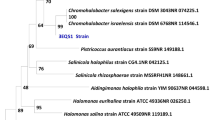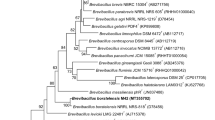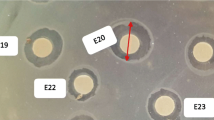Abstract
Extracellular polymeric substances (EPS) produced by a toxic dinoflagellate Amphidinium carterae Hulburt 1957 was isolated and characterized. Molecular masses of the EPS were about 233 and 1,354 kDa. Spectral analyses by 1H nuclear magnetic resonance and Fourier Transformed–Infrared Spectroscopy revealed the characteristic of the functional groups viz. primary amine, carboxyl, halide, and sulfate groups present in the EPS. However, five elements (C, O, Na, S, and Ca) were detected by scanning electron microscopy - energy dispersive X-ray spectroscopy (SEM-EDX) analysis. X-ray diffraction and differential scanning calorimetric analysis confirmed the amorphous nature of EPS, which was comprised of an average particle size of 13.969 μm (d 0.5) with 181 nm average roughness. Two monosaccharide constituents, galactose (73.13%) and glucose (26.87%) were detected by gas chromatography–mass spectroscopy analysis. Thermal gravimetric analysis revealed that degradation of EPS obtained from A. carterae takes place in three steps. The EPS produced by A. carterae was found to be beneficial for the growth of both A. carterae and Bacillus pumilus. The potential heterogeneous properties of EPS may play an important role in harmful algal bloom.









Similar content being viewed by others
References
Arias S, Moral AD, Ferrer MR, Tallon R, Quesada E, Bejar V (2003) Mauran, an exopolysaccharide produced by the halophilic bacterium Halomonas maura, with a novel composition and interesting properties for biotechnology. Extremophiles 7:319–326
Azam F (1998) Microbial controls of oceanic carbon flux: the plot thickens. Science 280:694–696
Bell WH, Lung JM, Mitchell R (1974) Selective stimulation of marine bacteria by algal extracellular products. Biol Bull 143:265–277
Bhaskar PV, Bhosle NB (2005) Microbial extracellular polymeric substances in marine biogeochemical processes. Curr Sci 88(1):10
Bradford MM (1976) A rapid and sensitive method for the quantification of microgram quantities of protein utilizing the principle protein–dye binding. Anal Biochem 72:248–254
Bremer PJ, Geesey GG (1999) An evaluation of biofilms development utilizing non-destructive attenuated total reflectance Fourier transform infrared spectroscopy. Biofouling 3:89–100
Chattopadhyay J, Sarkar RR, Abdllaoui AE (2002) A delay differential equation model on harmful algal blooms in the presence of toxic substances. IMA J Math Appl Med Biol 19:137–161
Chi Z, Zhao S (2003) Optimization of medium and cultivation conditions for pullulan production by new pullulan-producing yeast. Enzyme Microb Tech 33:206–211
De-Philippis R, Sili C, Paperi R, Vincenzini M (2001) Exopolysaccharide producing cyanobacteria and their possible exploitation: a review. J Appl Phycol 13:293–299
Domozych DS, Kort S, Benton S, Yu T (2005) The extracellular polymeric substance of the green alga Penium margaritaceum and its role in biofilm formation. Biofilms 2:129–144
Duan X, Chi Z, Wang L, Wang X (2008) Influence of different sugars on pullulan production and activities of a-phosphoglucose mutase, UDP-Gpyrophosphorylase and glucosyltransferase involved in pullulan synthesis in Aureobasidium pullulans Y68. Carbohyd Polym 73:587–593
Engel A (2000) The role of transparent exopolymer particles (TEP) in the increase in apparent particle stickiness (α) during the decline of a diatom bloom. J Plankton Res 22:485–497
Freitas F, Alves VD, Pais J, Costa N, Oliveira C, Mafra L, Hilliou L, Oliveira R, Reis MA (2009) Characterization of an extracellular polysaccharide produced by a Pseudomonas strain grown on glycerol. Bioresource Technol 100:859–865
Grabar KC, Freeman RG, Hommer MB, Natan MJ (1995) Preparation and characterization of Au colloid monolayers. Anal Chem 67(4):735–743
Grossart HP, Simon M (1998) Bacterial colonization, microbial decomposition of limnetic organic aggregates (lake snow). Aquat Microb Ecol 15:115–125
Ismael AA, Halim Y, Kalil A (1999) Optimum growth conditions for Amphidinium carterae Hulburt from eutrophic waters in Alexandria (Egypt) and its toxicity to the brine shrimp Artemia salina. Grana 38:179–185
Ittekkot V, Brockmann U, Michaelis W, Degen ET (1981) Dissolved free and combined carbohydrates during a phytoplankton bloom in the northern North Sea. Mar Ecol Prog Ser 4:299–305
Khandeparkar RDS, Bhosle NB (2001) Extracellular polymeric substances of the marine fouling diatom Amphora rostrata Wm. Sm. Biofouling 17:117–127
Kiemle SN, Domozych DS, Gretz MR (2007) The extracellular polymeric substances of desmids (Conjugatophyceae, Streptophyta): chemistry, structural analyses and implications in wetland biofilms. Phycologia 46(6):617–627
Kumar CG, Joo HS, Choi JW, Koo YM, Changa CS (2004) Purification and characterization of an extracellular polysaccharide from haloalkalophilic Bacillus sp. I-450. Enzyme Microb Technol 34:673–681
Manzoni M, Rollini M (2001) Isolation and characterization of the exopolysaccharide produced by Daedalea quercina. Biotechnol Lett 23:1491–1497
Martinez J, Smith DC, Steward GF, Azam F (1996) Variability in ectohydrolytic enzyme activities of pelagic marine bacteria and its significance for substrate processing in the sea. Aquat Microb Ecol 10:223–230
Mata JA, Bejar V, Llamas I, Arias S, Bressollier P, Tallon R, Urdaci MC, Quesada E (2006) Exopolysaccharides produced by the recently described bacteria Halomonas ventosae and Halomonas anticariensis. Res Microbiol 157:827–835
Mishra A, Jha B (2009) Isolation and characterization of extracellular polymeric substances from micro-algae Dunaliella salina under salt stress. Bioresource Technol 100:3382–3386
Myklestad SM, Haug A (1972) Production of carbohydrates by the marine diatom Chaetoceros affinis var. willei (Gran) Hustedt. II. Preliminary investigation of the extracellular polysaccharide. J Exp Mar Biol Ecol 9:137–144
Nayak BB, Karunasagar I, Karunasagar I (1997) Infuence of bacteria on growth and hemolysin production by the marine dinoflagellate Amphidinium carterae. Mar Biol 130:35–39
Nichols CM, Lardiere SG, Bowman JP, Nichols PD, Gibson JAE, Guezennec J (2005) Chemical characterization of exopolysaccharides from Antarctic marine bacteria. Microb Ecol 49:578–589
Parikh A, Madamwar D (2006) Partial characterization of extracellular polysaccharides from cyanobacteria. Bioresource Technol 97:1822–1827
Pavlova K, Grigorova D (1999) Production and properties of exopolysaccharide by Rhodotorula acheniorum MC. Food Res Intl 32:473–477
Ricou P, Pinel E, Juhasz N (2005) Temperature experiments for improved accuracy in the calculation of polyamide-11 crystallinity by X-ray diffraction. Advances in X-ray Analysis International Centre for Diffraction Data
Shimazu A, Miyazaki T, Ikeda K (2000) Interpretation of d-spacing determined by wide angle X-ray scattering in 6 FDA-based polyimide by molecular modelling. J Membrane Sci 166:113–118
Siddhanta AK, Goswami AM, Shanmugam M, Mody KH, Ramavat BK, Mahir OP (2001) Water soluble polysaccharide of marine algae species Ulva (Ulvales, Chlorophyta) of Indian waters. Ind J Mar Sci 30:166–172
Singh RP, Mantri VA, Reddy CRK, Jha B (2011) Isolation of seaweed associated bacteria and their morphogenesis inducing capability in axenic cultures of the green alga Ulva fasciata. Aquat Biol 12(1):13–21
Singh RP, Shukla MK, Mishra A, Kumari P, Reddy CRK, Jha B (2011b) Isolation and characterization of exopolysaccharides from seaweed associated bacteria Bacillus licheniformis. Carbohyd Polym 84:1019–1026
Smith DC, Steward GF, Long RA, Azam F (1995) Bacterial mediation of carbon fluxes during a diatom bloom in a mesocosm. Deep-Sea Res-II 42:75–97
Staats N, de Winder B, Stal LJ, Mur LR (1999) Isolation and characterization of extracellular polysaccharides from the epipelic diatoms Cylindrotheca closterium and Navicula salinarum. Eur J Phycol 34:161–169
Vardi A, Schatz D, Beeri K, Motro U, Sukenik A, Levine A, Kaplan A (2002) Dinoflagellate–cyanobacterium communication may determine the composition of phytoplankton assemblage in a mesotrophic lake. Curr Biol 12(20):1767–1772
Vieira AAH, Ortolano PIC, Giroldo D, Oliveira MJD, Bittar TB, Lombardi AT, Sartori AL (2008) Role of hydrophobic extracellular polysaccharide of Aulacoseira granulate (Bacillariophyceae) on aggregate formation in a turbulent and hypereutrophic reservoir. Limnol Oceanogr 53(5):1887–1899
Wang Y, Zhang M, Ruan D, Shashkov AS, Kilcoyne M, Savage AV, Zhang L (2004) Chemical components and molecular mass of six polysaccharides isolated from the sclerotium of Poria cocos. Carbohyd Res 339:327–334
Ye Z, Zhao X (2010) Phase imaging atomic force microscopy in the characterization of biomaterials. J Microscopy 238(1):27–34
Acknowledgments
The authors are thankful to Dr. B. Rabari, Mr. H. Gupta, Mr. V. Agarwal, and Mrs. P. Bhatt, Analytical Section, CSMCRI, for their enormous help during sample analysis. The authors are also thankful to Ms. D. Jain and Mr. I. Puncha for their help during sample collection. The work was supported by NWP 0018, Council of Scientific and Industrial Research, New Delhi, and SAC-CSMCRI collaborative project (GAP 1049).
Author information
Authors and Affiliations
Corresponding author
Electronic supplementary material
Below is the link to the electronic supplementary material.
ESM1
(DOC 223 kb)
Rights and permissions
About this article
Cite this article
Mandal, S.K., Singh, R.P. & Patel, V. Isolation and Characterization of Exopolysaccharide Secreted by a Toxic Dinoflagellate, Amphidinium carterae Hulburt 1957 and Its Probable Role in Harmful Algal Blooms (HABs). Microb Ecol 62, 518–527 (2011). https://doi.org/10.1007/s00248-011-9852-5
Received:
Accepted:
Published:
Issue Date:
DOI: https://doi.org/10.1007/s00248-011-9852-5




